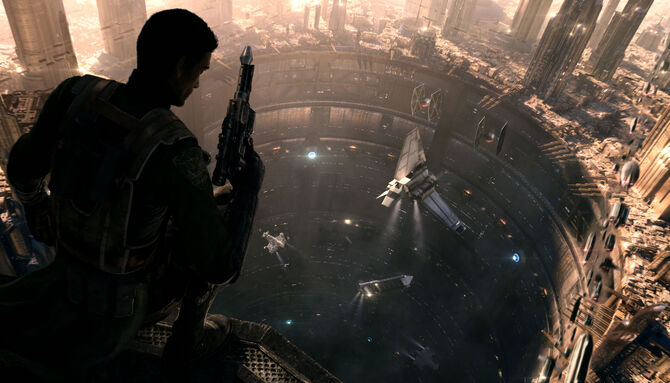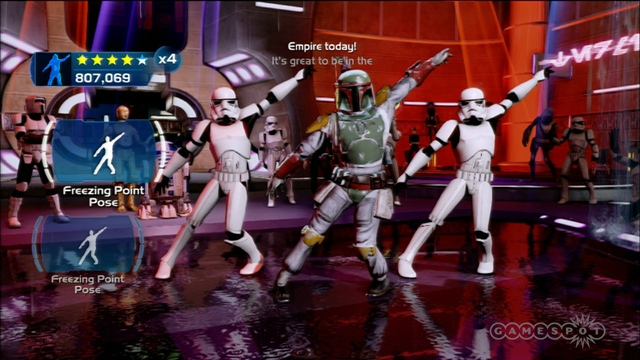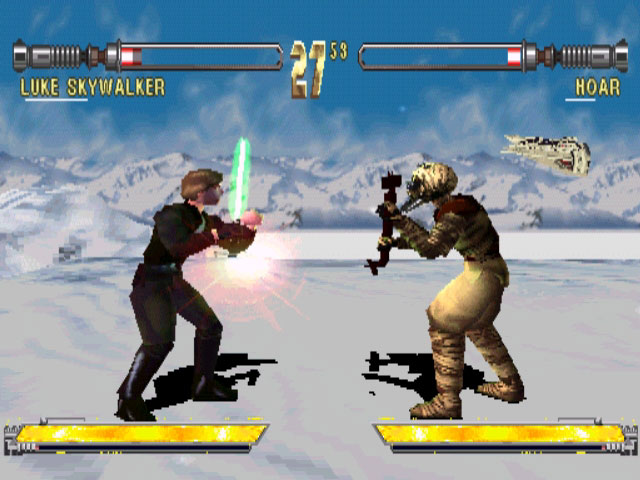
Being both a Star Wars fan and an avid video game player has been a rough road in the past few years. The fact that LucasArts, the videogame production arm of Lucasfilm, was closed by Disney shortly after their acquisition of the company, but even the past five or six years before that were disappointment after disappointment. In the last four years, we have Star Wars Angry Birds, The Force Unleashed II, Kinect Star Wars, Star Wars: Clone Wars Adventures, Lego Star Wars III: The Clone Wars and The Old Republic. That’s it and all. Going back two or three years more gives us Battlefront: Elite Squadron, Battlefront: Renegade Squadron, The Force Unleashed in both initial release and the “Ultimate Sith” edition, three other Clone Wars tie-in games, and Lego Star Wars: The Complete Saga.
Out of that list, only five games not tying in to the Clone Wars TV show made it to the mainstream console market: TFU, TFU II, Lego SW: Complete and Kinect Star Wars. The biggest release by far, however, is The Old Republic, a game developed over a five-year cycle that cost LucasArts, EA and Bioware $200 million to make, more than many blockbuster movies. While an argument can be made for all of these games relative to how fun they are to play or how entertaining they are, no one will argue that any of them are original, exciting and new concepts in the realm of video games.
The Force Unleashed was developed at a time when the hack-’em-up genre was just starting to get big. Sony’s God of War is the clearest inspiration, coming out in 2005, three years before TFU was released, and while TFU does a lot to try and distance itself from its inspiration, the level design, character movement and animation and combat fundamentals are all almost exactly the same. TFU II took more liberties with the formula and tried to change up the raw gameplay by adding more visceral combat and improving the Force mechanics, but its even more derivative and repetitive level design and borderline insultingly short main story turned gamers away, even those who had enjoyed the first game.
Kinect Star Wars hardly has to be discussed. Just the name alone elicits groans, confused expressions and laughs of derision from most fans. A hodgepodge of smaller games collected under one title, Kinect Star Wars is best known for its dancing section, where Star Wars-ified versions of pop songs throb as players try to match their physical movement to the actions shown on screen, using a design and engine lifted wholesale from the popular Dance Central series of games. The other modes, such as podracing, flailing about as a Jedi or destroying a Tatooine town as a Rancor all suffer from the imprecise controls, meaning the game has to take much of the control away from the player to even operate.

The Old Republic, distant cousin to the previous Star Wars MMO Star Wars: Galaxies, began its development when the biggest force in the genre was World of Warcraft, and the game wears that influence on its sleeve. Questing systems, transportation, level design, experience gain and looting mechanics are all just one step or less removed from WoW, with only the game’s reliance on story and a fully-voice-acted dialogue system to differentiate the two (aside from obvious aesthetic differences). While the game was one of the fastest-growing MMOs of all time, it lost subscribers at an alarming rate after hardcore MMO fans found the endgame content lacking compared to WoW and departed for greener pastures. EA and LucasArts were forced to turn the game to a free-to-play model to lure in new players, settling into an uneasy medium between paid and free content as they try to make good on their massive investment.
As I said at the top, the last few years have not been kind for Star Wars video game fans. The lack of success of a lot of the games I listed and featured meant that Disney’s decision to close the LucasArts studio was not murder so much as it was putting down a horse with a shattered leg, a mercy killing for a division of the company that had been steadily losing money for years. A lot of players and critics were quick to blame derivative concepts and gameplay for the studio’s fall, citing all four of the games I discussed above as examples of just how creatively bankrupt the studio had become.
I, for one, disagree. Star Wars video games have been derivative and unoriginal in a lot of ways since their very inception, and some of the most popular Star Wars games of all time wear their influences on their sleeves just as brazenly as TOR and TFU do.
Going back to the year 1993, we have the release of Star Wars: X-Wing, a game which would spawn two expansions and three sequels, including the highest-rated Star Wars game of all time, TIE Fighter. The success and popularity of these games does obscure their direct influence a bit, but a bit of it likely comes from the far cruder Star Wars: The Arcade Game developed by Atari in 1983, which was in turn heavily influenced by the flight simulators of the time, such as Interceptor, a first-person flight and combat simulator controlled via a joystick, developed way back in 1975 by the same man who went on to make the seminal Space Invaders. X-Wing’s flight simulator roots meant the game had solid mechanics built in, leaving the LucasArts team free to focus on level design, enemy AI and in-game model-work.
Jumping forward to 1995, we have Star Wars: Dark Forces, a First-Person-Shooter made when FPS games were in their genesis years. Doom, the first FPS to make it in the mainstream market, had released two years before, in 1993, and immediately spawned a legion of imitators and apes trying to cash in on its rousing success, meaning that the term “FPS” was left aside in favor of calling them “Doom-clones”. Dark Forces was one of those games. However, as with X-Wing, utilizing Doom as a basis meant that the developers had a solid core to build from and allowed them to focus on something virtually unheard of in FPS games of the time: a story, with cutscenes, recorded dialogue and a main character with actual personality.
 I could continue in this vein for some time. Masters of Teras Kasi, released in 1997, was heavily influenced by the Mortal Kombat series, especially Mortal Kombat: Armageddon, the first game in the series to have 3D graphics and gameplay. Star Wars: Rebellion, known overseas as Star Wars: Supremacy, was based on 4X (explore, expand, exploit, exterminate) strategy games like Masters of Orion III. It would be far less time-consuming to discuss the Star Wars games that did not have open and clear influences from more mainstream games.
I could continue in this vein for some time. Masters of Teras Kasi, released in 1997, was heavily influenced by the Mortal Kombat series, especially Mortal Kombat: Armageddon, the first game in the series to have 3D graphics and gameplay. Star Wars: Rebellion, known overseas as Star Wars: Supremacy, was based on 4X (explore, expand, exploit, exterminate) strategy games like Masters of Orion III. It would be far less time-consuming to discuss the Star Wars games that did not have open and clear influences from more mainstream games.
The main crux of my argument, then, is this: the derivative nature of Star Wars video games did not lead to the death of LucasArts, nor did they indicate a creative bankruptcy in the company that would lead to its demise. Derivative concepts and gameplay styles by themselves mean nothing. Instead, I would propose that games like The Force Unleashed represent issues with the video game industry as a whole, and that LucasArts was a victim of a change in tide and time due to ineffective management and a lack of vision for both the company and the brand they were shepherding.
The gradual fall of LucasArts also coincided with the release of the seventh console generation, with both the Xbox 360 and the Playstation 3 coming out in the same 2005-6 time period that gave us the last era of successful Star Wars game releases. It was just after the release of Revenge of the Sith, the brand was strong and so was interest in Star Wars games, so production and sales were at an all-time high. LucasArts developed only two games by itself in that time span, Republic Commando and Battlefront II, the latter of which was largely based on work done for the first game by a different company, but they published many more: Empire at War, Lethal Alliance, the original Lego Star Wars, and more.
Note that these games weren’t wholly original concepts, with RepCom being a mash-up of the Rainbow Six and Halo franchises of shooters and EaW not only being based on Command and Conquer, but also developed by some of the same people; even Battlefront, the best-selling Star Wars game series of all time, was based on the Battlefield series of games with their “capture the command point” objectives and emphasis on mid- to large-scale battles. That did not stop any of them from being critical and commercial successes, still played and beloved by many to this day. It’s also important to note that, while most of these games were not developed by LucasArts itself, oftentimes concepts were put together by the studio and then given to respected third-party developers to produce on a certain budget. This practice meant a high volume of games were produced to tie in to the release of each of the Prequel films, especially between 2002-2005 when the Clone Wars were being fleshed out.
After this period, however, a lot of the studios LucasArts had partnered with either closed down for other reasons (Pandemic, who developed Battlefront) or would have their contracts run out and not renewed (Petroglyph, who developed Empire at War). This meant Star Wars games became fewer and farther between as the handful of developer teams both in and out of LucasArts itself were pushed harder to produce titles. The lack of a movie tie-in also hurt development prospects, something the release of The Clone Wars did not help to abate, with most of the games tying in to that property being dumped on both critically and in terms of sales.
At the same time, the economics of video game development were changing. Massive games with massive budgets became more and more common as studios sought to create the next million-copy seller, the next Call of Duty: Modern Warfare or World of Warcraft. Mirroring the movie industry, a push began for game developers to use the more powerful hardware of the seventh generation consoles to its fullest extent. To that end, a trend began: singular blockbuster releases. Major developers would leave aside smaller projects and lower budgets, farming that work out to lesser studios to keep day-to-day operations flowing, while their main teams would create “tentpole” games, games that the entire company was supported by, games so costly that they could make or break a studio merely by being created.

LucasArts attempted to follow that lead for some time. Whilst shoveling out the license to developers like TT Games, who made Lego Star Wars, or aptly-named Rebellion Developments, who developed the two Battlefront portable games, the main studio focused on bigger, more advanced projects. Unfortunately, a number of these blockbuster games LucasArts tried to develop were either canceled before they could be finished or languished in what is commonly referred to as “Development Hell”. Though The Force Unleashed was a modest critical success and sold quite well, its sequel was a horrible failure, and projects like the Uncharted-inspired 1313, a next-gen Battlefront game and a third Force Unleashed game were re-worked, pushed back, restarted multiple times due to producer changes, and ultimately left to die.
Numerous other articles have been written about the managerial issues LucasArts went through in its last years, especially when it came to actual game development. Confusion reigned as executives were hired, vowed to help the company get on its feet and release great games again, only to quit a few years later, often before projects they had overseen or greenlighted were released. While the company stayed afloat thanks to the successes of third-party games, production of its own games was almost nonexistent, and even completely abandoned at times. And through it all went George Lucas himself, who often had projects changed drastically on a whim while they were deep in development, forcing delays and wasting time and money.
LucasArts did not close because they made derivative games. They closed because their management could not see that the model other development studios were adapting, of making the biggest games themselves while leaving the smaller projects to outside studios, was a bad choice to follow. Star Wars games had moved beyond being developed solely by one studio, and focusing all of their efforts on singular releases like The Force Unleashed and The Old Republic meant that, if those games failed or even struggled, the entire company would go with it, regardless of the successes or failures of games developed by outside companies.
Ironically enough, now that the development arm of LucasArts has been shut down, Star Wars games are going back toward the model used in the RotS tie-in era: farming the license out to a number of studios, giving them a concept and then the freedom to make the game their way. It just so happens that all of the studios involved will be under the banner of EA, but that’s another article entirely.
Pondering what might have been is an exercise in futility. LucasArts was a company that, for almost a decade, struggled with its own identity and concepts. In the end, it could not find one in time to save itself in a fast-changing world of game development. Star Wars gamers such as myself are quick to lay blame as to why the company failed, but the successes of the distant past hardly guaranteed that anything produced in the future would have been any better. The LucasArts that created games like TIE Fighter and Dark Forces has been gone far longer than most fans realize.
I, befitting my cynical nature, am skeptical of what the future may bring in EA’s hands. But the nature of Star Wars gaming is a nebulous one regardless of the era or license-holder, games of mixed quality and originality are all over the place. So long as we don’t get Star Wars Kinect II, though, I’ll probably be okay with it.

I believe the strange things that happened during the development of EaW were the first sign that something was wrong at LA. Petroglyph clear planned on using existing stuff, like the 1-M Imperial-class repulsortank and Dodanna-class assault frigate, only to suddenly come with with a lot of new stuff out of nowhere to replace it, like the 2-M Saber-class repulsortank and the Assault Frigate Mark II. Combined with a failure to continue prosperous franchises, namely the X-wing and TIE Fighter series, the Battlefront series, and Republic Commando, and not even letting anyone finish their stories even when it became clear that they had no intention of doing it themselves, i.e. Sev from Republic Commando, and its no wonder LA was long past its prime.
I think The Old Republic should be defended t some degree. Though mechanistically the game does indeed borrow very heavily from WoW, it is not completely un-innovative. The depth of story elements for the single-player game, and the considerably greater immersive effect of having the entire game conducted in full voice are innovative, at least compared to the game’s contemporaries like GW2 or FFXIV. The game has been a business failure to a degree, but not a storytelling one.